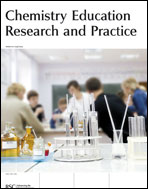ANALOGIES IN CHEMISTRY TEACHING AS A MEANS OF ATTAINMENT OF COGNITIVE AND AFFECTIVE OBJECTIVES: A LONGITUDINAL STUDY IN A NATURALISTIC SETTING, USING ANALOGIES WITH A STRONG SOCIAL CONTENT
Abstract
A longitudinal study of the use of chemical analogies and their effect on cognitive and affective factors of tenth- and eleventh-grade Greek students in a naturalistic setting is reported. Attention was paid to the structural correspondence between the analogue and the target. Regarding the analogue domain, emphasis was placed on using analogies with a strong and familiar social context. An experimental-control group design was adopted. Although it is difficult to separate the direct effect of the analogies from the social relevance and the enjoyment factors, our findings from questions set immediately after the introduction of each analogy, as well as from final examinations, provide evidence for the possible usefulness of the long-term use of analogies in the teaching of chemistry. Gender was found to make no difference. Analogies can be more effective for lower cognitive development students. A positive affective effect to most students was also found. Both developmental level and motivational trait play a definitive role, with the concrete students on the one hand, and the curious students on the other found to be more favourably disposed to this teaching strategy. Finally, recommendations for the proper and effective use of analogies in chemistry teaching are made. [Chem. Educ. Res. Pract.: 2004, 5, 33-50]

 Please wait while we load your content...
Please wait while we load your content...